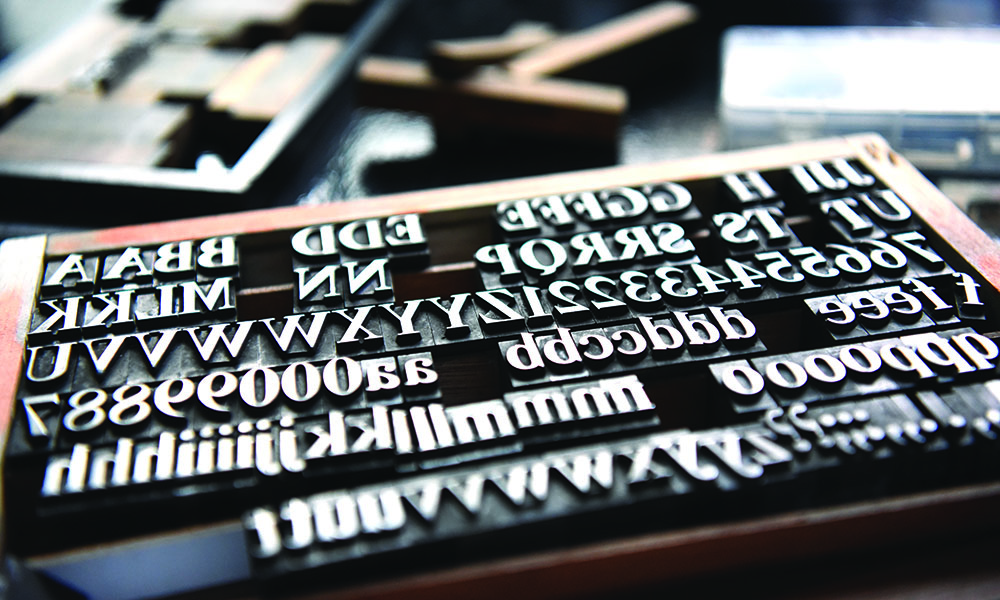By Jocelyn Neo |
In the studio of Typesettingsg situated at Pearl’s Hill Terrace, composing sticks, trays of metal types, printing presses and inks – remnants of a forgotten traditional art – are found lying on the table, stacked on shelves or kept in the drawers.
There is a certain beauty and elegance to this traditional art that reflects the simplicity of yesteryears. Decades ago, the letterpress – a printing technique, in which a hard surface of raised letters is covered with ink and pressed onto paper – was the method for printing everything from books to billboards.
Letterpress is the bedrock of graphic design and typography. Why are we not learning the history of it in Singapore?
Sun Yao Yu, Founder of Typesetting.sg
Letterpress, which dates back to the mid-15th-century, was invented by Johannes Gutenberg, a German printer and publisher whose invention was regarded as the cradle of modern human civilisation. In the West, prior to letterpress, monks had been writing manuscripts by hand to store and disseminate information, which could take months or years to finish.

In the East, printing has a longer history that dates back to the Tang Dynasty. The Diamond Sutra, a Buddhist scripture, was the first known work of block printing, produced in 868 AD. In the Song Dynasty, in 1041, Bi Sheng improvised this printing technique and formulated moveable type printing.
Sun Yao Yu – founder of Typesettingsg, a small studio – is a dedicated follower of this traditional art form. His passion for the craft galvanised him to restore the art of letterpress.

According to Yao Yu, the first letterpress studio in Singapore was established in 1823; the first set of well designed Chinese letterpress types was partially cut and cast in Singapore by the London missionary society, and the first world printing congress was held in Singapore in 1978. Thus, he strongly believes the “need to preserve letterpress as it had been part of Singapore’s history since the start”.

Yao Yu had a tired expression hovering over his face, and after speaking to him, I could understand why.
Learning Letterpress and Setting Up a Studio
Yao Yu quit his designer job and set up his typesetting studio in 2014.
Having graduated from RMIT in graphic design, he has always been interested in this traditional art as he feels “letterpress is actually [fundamental to] graphic design and typography”.
He also believes that it is essential for students to learn about letterpress.
“There is a need for designers to know the root of where [design] comes from,” he says with a dignified and serious expression.
“Letterpress is the bedrock of graphic design and typography. Why are we not learning the history of it in Singapore? If you are in a good overseas university, they will have a letterpress department,” he says emphatically. “You learn design but you don’t know where design comes from. That is totally wrong.”
In fact, he elucidates that “all the typography terms such as point system and kerning” are actually derived from letterpress.
Since letterpress was not taught in schools, where and how did Yao Yu master the craft?
He emphasises, “There is nothing in Singapore.” He was self-taught through reading books on letterpress and online research.
“To learn letterpress in Singapore is practically not possible. There are still many old letterpress printers in the printing industry, but they are not able to equip you with that understanding and the knowledge of what is letterpress,” he says.
Letterpress printing is a tedious and complex process and it is not an easy skill to master, as “it is not like in the modern day context where you press a button (on a printer), and that’s it”.
“I actually conversed through emails with many Western printers. That is how I master the trade; I have to go through a long period of trial and error,” he says, adding that there is no one in Singapore who can teach him.
“I’m still learning and I’m halfway through the apprenticeship programme,” he says humbly, alluding to the old days. Back then, a printer required seven years of apprenticeship.
Listening to his onerous learning process, it is not hard to believe that most of the tools in his studio are bought from overseas. He did, however, try to source for tools locally from antique shops.
“The Western Latin alphabets are from Europe and the US, whereas the Chinese (types) are from Taiwan and China,” he explains.
He acquired second-hand metal types online and had them air-shipped to Singapore. Second-hand types are also more affordable as type from the foundries can cost up to thousands of dollars.
After years of amassing types from different parts of the world, Yao Yu now has an impressive collection of over 100 set of types in his studio.
Preserving a Traditional Art
As design schools in Singapore are not equipped with the necessary tools to teach students letterpress, according to Yao Yu, he has been imparting his knowledge by conducting workshops for those who are interested to learn this traditional art. To date, he has conducted numerous workshops for over 300 students at his studio.
He also organises exhibitions and gives talks to the general public on letterpress printing and its history.
His hope is that people will come to appreciate the art though his workshop and slowly pick it up themselves. He hopes his studio will be the educational resource for learning letterpress in Singapore.
However, the number of people who are interested in letterpress is on a decline as compared to two years ago, says Yao Yu. Recently, he has been receiving only one or two students in a month.
Walking the traditional route is never easy and Yao Yu has to undertake freelance design to supplement his income and support his studio, which may have to close down next year.
“We are more into the traditional form of letterpress, whereas on the commercial side, they are always looking for contemporary letterpress that has a deep debossed effect, and this is something we don’t do.”
“The machine used to print contemporary letterpress is the same, except that contemporary letterpress has a deep debossed effect, which is the ‘impression’. Contemporary letterpress is able to survive as it has differentiated itself from the normal way of printing,” he says.
As Yao Yu explained this phenomenon, a tinge of disappointment was apparent on his face. He feels that contemporary letterpress has not passed down the right knowledge, history and value of letterpress.
To make matters worse, says Yao Yu, if someone where to use the metal types to do this debossed effect, most likely the type will be smashed or the life span will be cut short by a lot as types are make of high percentage of lead contain.
“When types are destroyed, the history will be gone with it as there aren’t many foundries that are still actively casting types,” he bewails.
He adds indignantly, “It is just not possible in Singapore to do something that [has more of an intangible value] rather than the tangible value that you can measure.”
“We (at Typesettingsg) are more into passing down the value of traditional letterpress in the form of the process,” he asserts with a resolute glint in his eyes.
For Yao Yu, letterpress is not a pleasant diversion but a traditional art, which he strives to preserve.
For demonstration of letterpress printing, please visit https://youtu.be/77mk0kjy2FU
















